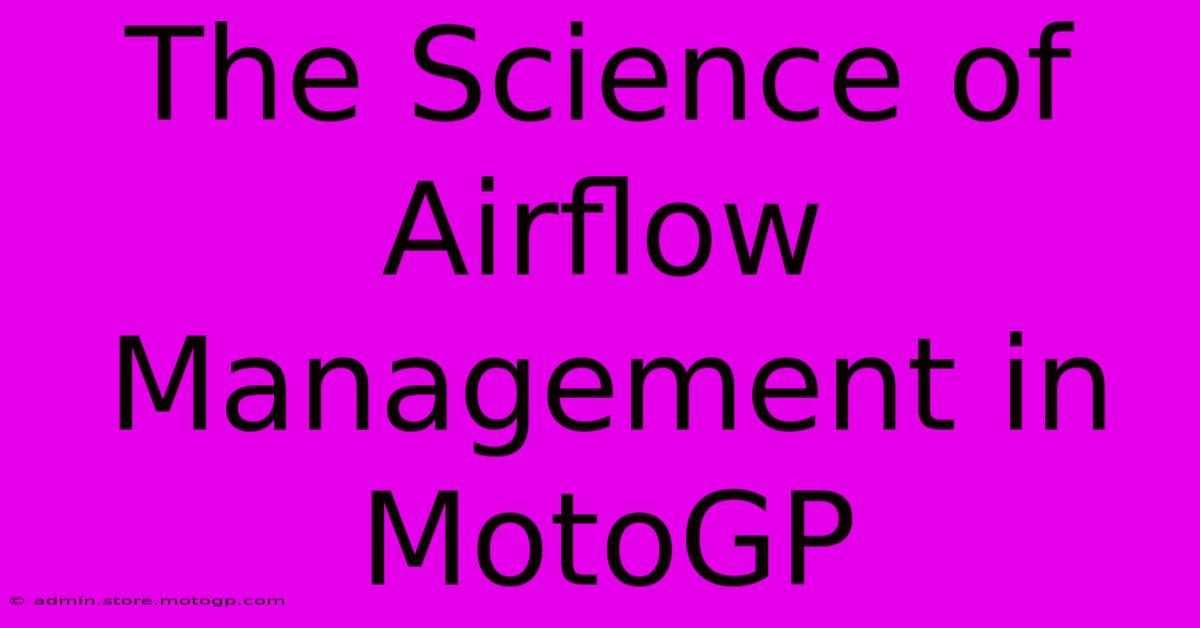The Science Of Airflow Management In MotoGP

Table of Contents
The Science of Airflow Management in MotoGP
MotoGP bikes are marvels of engineering, pushing the boundaries of speed and performance. A critical element contributing to their breathtaking speed and handling is sophisticated airflow management. This isn't just about aesthetics; it's a complex interplay of aerodynamics, physics, and data analysis that directly impacts rider performance and lap times. This article delves into the science behind airflow management in MotoGP, exploring the key components and their impact on race results.
Understanding the Aerodynamic Challenge
MotoGP bikes operate at incredibly high speeds, generating significant aerodynamic forces. These forces, if not carefully managed, can lead to instability, reduced speed, and ultimately, crashes. The challenge lies in harnessing the power of airflow to create downforce (pushing the bike towards the track) for better cornering and stability, while simultaneously minimizing drag (resistance to forward motion) to maintain high speeds on straights.
The Role of Downforce
Downforce is crucial for high-speed cornering. It increases the grip of the tires on the track, allowing riders to lean into turns at higher speeds without losing control. This is achieved through strategically designed aerodynamic components:
-
Winglets: These small, wing-like structures are placed on the front fairing and sometimes the rear. They generate downforce by deflecting airflow downwards. The precise angle and shape of winglets are meticulously designed to maximize downforce while minimizing drag. Variations in winglet design are constantly being experimented with by teams, representing a significant area of competitive advantage.
-
Fairings and Bodywork: The overall shape and design of the bike's fairing are crucial. Computational Fluid Dynamics (CFD) simulations play a vital role in optimizing the fairing's shape to channel airflow effectively, generating downforce and reducing drag. Even small changes in the fairing's contours can significantly impact performance.
Minimizing Drag
While downforce is essential, excessive drag significantly hinders speed. Teams work tirelessly to minimize drag using various techniques:
-
Streamlined Design: The overall shape of the bike is designed to be as aerodynamically efficient as possible. This involves careful consideration of the airflow around every component, smoothing out any irregularities that could create turbulence and increase drag.
-
Aerodynamic Appendages: While winglets generate downforce, their design must carefully balance downforce generation with drag reduction. Teams constantly refine these appendages to optimize this balance.
-
Rider Position: Even the rider's position contributes to drag. A streamlined riding posture can minimize the disruption of airflow around the bike, thus reducing drag.
The Technology Behind Airflow Management
The development and refinement of aerodynamic components rely heavily on advanced technology:
-
Computational Fluid Dynamics (CFD): This computer-aided engineering technique allows engineers to simulate airflow around the bike in a virtual environment. This allows for the testing of various designs and modifications without the need for expensive and time-consuming wind tunnel tests.
-
Wind Tunnel Testing: Despite the advancements in CFD, wind tunnel testing remains crucial. This allows engineers to validate CFD simulations and fine-tune designs under real-world conditions.
-
Data Acquisition and Analysis: During testing and races, numerous sensors collect data on airflow characteristics around the bike. This data is then analyzed to further optimize aerodynamic performance.
The Ever-Evolving Landscape of MotoGP Aerodynamics
The science of airflow management in MotoGP is constantly evolving. Teams are always searching for incremental improvements, pushing the boundaries of what's possible. New materials, manufacturing techniques, and aerodynamic concepts are continually being explored, leading to a perpetual arms race in the pursuit of ultimate performance. The complexities of airflow management, coupled with the intense competition, ensure that this field remains at the cutting edge of technological innovation in motorsport. The quest for aerodynamic perfection continues to drive the evolution of MotoGP bikes, delivering ever-faster lap times and more exhilarating races.

Thank you for visiting our website wich cover about The Science Of Airflow Management In MotoGP. We hope the information provided has been useful to you. Feel free to contact us if you have any questions or need further assistance. See you next time and dont miss to bookmark.
Featured Posts
-
How Moto Gp Announcers Enhance The Viewing Experience
Feb 20, 2025
-
Moto Gp A Spectacle Of Speed Tnt Sports
Feb 20, 2025
-
Moto Gp Watch Experience The Speed And Skill
Feb 20, 2025
-
Exclusive Yamaha Moto Gp Team News And Rider Insights
Feb 20, 2025
-
Moto3 Bikes Master The Art Of Moto3 Riding
Feb 20, 2025
